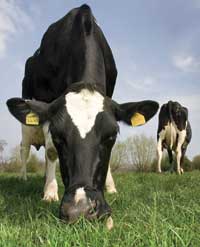Large Herds Seminar: Don’t ‘steam up’ dry cows

“Steaming up” dry cows prior to calving is unnecessary, said Ric Grummer, Department of Dairy Science, University of Wisconsin-Madison.
Too much emphasis had been placed on the pre-calving energy requirements of dry cows, he said. “In reality, the real energy challenge comes after calving.
“Cows do not go into negative energy balance until after calving, when reduced dry matter intakes means energy supply lags behind the needs of the cow,” Dr Grummer explained.
“The idea of ‘steaming up’ cows three weeks prior to calving, by feeding increased energy levels, is to promote dry matter intake, which it undoubtedly does.”
But why feed high levels of concentrate when a cow was not in negative energy balance?
“There is no evidence to suggest feeding a higher energy diet close to calving has any effect on post-calving dry matter intakes or milk yield. And as such we can presume there is no effect on negative energy balance,” he said.
In fact, feeding additional concentrates prior to calving may result in a greater crash in DMI post-parturition. “So, in reality, there is a lot of flexibility in pre-calving diets.”
Management factors such as pen changes, overcrowding or heat stress, that trigger reduction in DMI, may also be more detrimental when cows had been fed higher concentrate diets and had the potential for greater reduction in intakes.
Research had shown feeding dry cows in the far-off-from-calving period was more influential than diets in the close-to-calving period.
“Traditional opinion says dry cows, far off from calving, should be fed a straw-based, bulky diet to meet energy requirements. However, our initial work has shown additional energy feeding in the far-off-from-calving period can give an average 5kg a day more milk.
“This is something that cannot be ignored, but we must undertake more studies for us to come to any firm conclusions,” stressed Dr Grummer.
But, these findings suggest, diets for dry cows far off from calving, did not have to be “just right” and there was substantial variability in diets that could be fed, without adverse effects.
